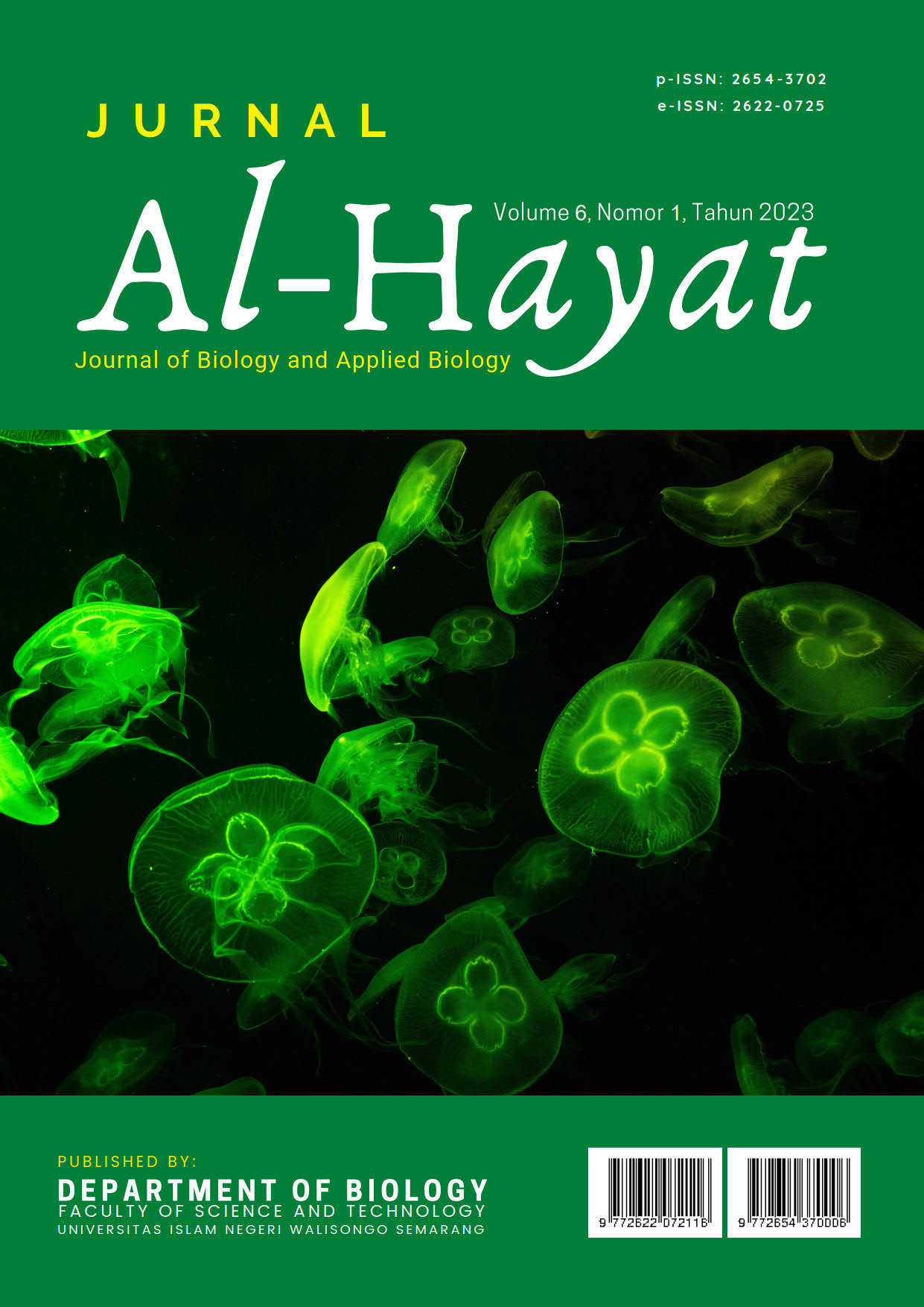Authentication of Wax Apple (Syzygium samarangense (Blume) Merr. & L.M Perry) Delima and Citra Cultivars by Morphological and Molecular Approach
Main Article Content
Abstract
Wax apple Delima and Citra Cultivars are two superior non-climacteric tropical fruit commodities from Demak Regency which have similar morphological characters but have different fruit characteristics. Identification wax apple cultivars from Demak regency using DNA barcoding approach has not been researched yet. The aims of this research are to analyze the morphological similarities of wax apple between Delima and Citra cultivars and to identify genetic variations of wax apple Delima and Citra using trnL-trnF intergenic spacer for molecularly authentication. The results shown that there were no differences in the environmental parameters of the wax apple two cultivated area in Demak Regency. According to the morphological approach, the Delima and Citra cultivars in Demak Regency were grouped separately into Delima and Citra clusters with a similarity index of 61.5% (Citra cultivars) and 60.5% (Delima cultivars) and separated based on the origin of their cultivation area. Genetic variations between wax apple Delima and Citra in Demak Regency consisted of deletions (9delA & 17delA) and conserved P6 loop in all compared cultivars. The possibility of heteroplasmy R (A,G) found at 73 nucleotide number in Delima Betokan cultivar and Citra cultivars (Betokan and Jungpasir). Meanwhile, Delima Jungpasir cultivar is K (G,T). There were P8 stem-loops with different lengths between Delima cultivars (Betokan and Jungpasir) and the same length in Citra cultivars (Betokan and Jungpasir). Therefore, the trnL-trnF intergenic spacer has not been thoroughly used in wax apple Delima and Citra authentication due to the presence of a secondary structure which causes the loss of the electropherogram signal so that the nucleotide sequence cannot be read.
Downloads
Article Details
The copyright of the received article shall be assigned to the journal as the publisher of the journal. The intended copyright includes the right to publish the article in various forms (including reprints). The journal maintains the publishing rights to the published articles. Authors are allowed to use their articles for any legal purposes deemed necessary without written permission from the journal with an acknowledgment of initial publication to this journal.
The work under license Creative Commons Attribution-ShareAlike 4.0 International License.
References
Applequist, W. L., & Wallace, R. S. (2002). Deletions in the plastid trnT-trnL intergenic spacer define clades within Cactaceae subfamily Cactoideae. Plant Systematics and Evolution, 231, 153–162. https://doi.org/10.1007/s006060200017
DeSalle, R., & Goldstein, P. (2019). Review and Interpretation of Trends in DNA Barcoding. Frontiers in Ecology and Evolution, 7, 1–11. https://doi.org/10.3389/fevo.2019.00302
Fazekasova, D. (2021). Evaluation of Soil Quality Parameters Development in Terms of Sustainable Land Use. In S. Curkovic (Ed.), Sustainable Development – Authoritative and Leading Edge Content for Environmental Management bring (pp. 435–457). https://doi.org/http://dx.doi.org/10.5772/48686
Flickinger, J. A., Jestrow, B., Prieto, R. O., Santiago-valentín, E., Sustache-sustache, J., Jiménez-rodríguez, F., & Campbell, K. C. S. E. (2020). A phylogenetic survey of Myrtaceae in the Greater Antilles with nomenclatural changes for some endemic species. Taxon, 69(3), 448–480. https://doi.org/10.1002/tax.12263
Hall, T. (2011). BioEdit: An important software for molecular biology. GERF Bulletin of Biosciences, 2(June), 60–61.
Hoang, N. V., Furtado, A., McQualter, R. B., & Henry, R. J. (2015). Next generation sequencing of total DNA from sugarcane provides no evidence for chloroplast heteroplasmy. New Negatives in Plant Science, 1–2, 33–45. https://doi.org/10.1016/j.neps.2015.10.001
Kishor, R., & Sharma, G. J. (2018). The use of the hypervariable P8 region of trnL (UAA) intron for identification of orchid species: Evidence from restriction site polymorphism analysis. PLoS ONE, 13(5). https://doi.org/10.1371/journal.pone.0196680
Kumar, S., Stecher, G., Li, M., Knyaz, C., & Tamura, K. (2018). MEGA X: Molecular evolutionary genetics analysis across computing platforms. Molecular Biology and Evolution, 35(6), 1547–1549. https://doi.org/10.1093/molbev/msy096
Mukaromah, A. S. (2020). Wax Apple ( Syzygium samarangense ( Blume ) Merr . & L . M . Perry ): A Comprehensive Review in Phytochemical and Physiological Perspectives. Al-Hayat: Journal of Biology and Applied Biology, 3(1), 40–58. Retrieved from https://doi.org/10.21580/ah.v3i1.6070
Nguyen, K.-B., Tran, G.-B., & Van, H. (2020). Comparison of five wax apples (Syzygium samarangense) from Dong Thap Province, Vietnam based on morphological and molecular data. Banat’s Journal of Biotechnology, 11(21), 50–57.
Shearman, J. R., Sonthirod, C., Naktang, C., Sangsrakru, D., Yoocha, T., Chatbanyong, R., … Pootakham, W. (2020). Assembly of the durian chloroplast genome using long PacBio reads. Scientific Reports, 10(1), 1–8. https://doi.org/10.1038/s41598-020-73549-4
Taberlet, P., Coissac, E., Pompanon, F., Gielly, L., Miquel, C., Valentini, A., … Willerslev, E. (2007). Power and limitations of the chloroplast trnL (UAA) intron for plant DNA barcoding. Nucleic Acids Research, 35(3). https://doi.org/10.1093/nar/gkl938
Taberlet, P., Gielly, L., Pautou, G., & Bouvet, J. (1991). Universal primers for amplification of three non-coding regions of chloroplast DNA. Plant Molecular Biology, 17(5), 1105–1109. https://doi.org/10.1007/BF00037152
Ubaidillah, R., & Sutrisno, H. (2009). Pengantar Biosistematika: Teori dan Praktik. Bogor: Pusat Penelitian Biologi LIPI.
Vere, N. De, Rich, T. C. G., Trinder, S. A., & Long, C. (2015). Dna barcoding for plants. In Jacqueline Batley (Ed.), Plant Genotyping: Methods and Protocols, Methods in Molecular Biology (Vol. 1245, pp. 101–118). https://doi.org/10.1007/978-1-4939-1966-6_8
Weaver, A. R., Kissel, D. E., Chen, F., West, L. T., Adkins, W., Rickman, D., & Luvall, J. C. (2004). Mapping Soil pH Buffering Capacity of Selected Fields in the Coastal Plain. Soil Science Society of America Journal, 662–668. https://doi.org/https://doi.org/10.2136/sssaj2004.6620
Widodo, P. (2015). Jambu Semarang dan Jambu Air. Universitas Jenderal Soedirman.
Yulita, K. S. (2007). Mutasi structural intron trnL (UAA) pada suku meranti-merantian (Dipterocarpaceae) [Structural Mutation of trnL intron (UAA) in Dipterocarpaceae]. Berita Biologi, 8(6), 433–444.
Yulita, K. S. (2013). Secondary Structures of Chloroplast trnL Intron in Dipterocarpaceae and its Implication for the Phylogenetic Reconstruction. HAYATI Journal of Biosciences, 20(1), 31–39. https://doi.org/10.4308/hjb.20.1.31

